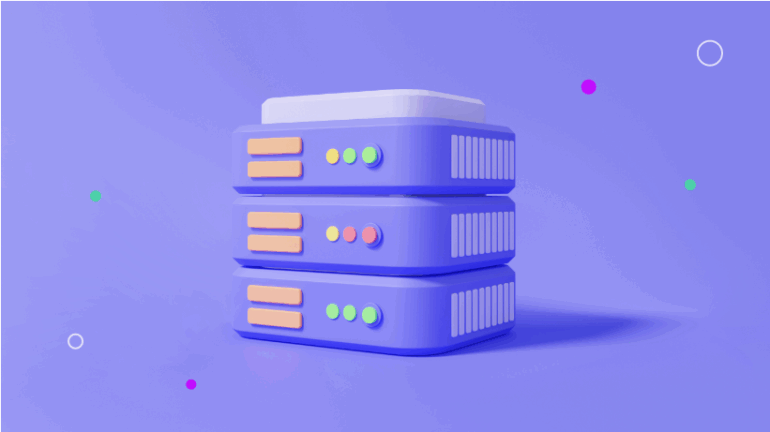
| Internet Protocol(IP) | Description | Larger Payload |
|---|---|---|
| IPv4 | Internet Protocol Version 4 (IPv4) was the first version deployed for production in ARPANET in 1983.reference | No |
| IPv6 | Internet Protocol Version 6 (IPv6) has been developed as a replacement for IPv4, providing more addresses and features.reference | Yes |
The king of protocols when discussing the internet is without doubt IPv6. Internet Protocol Version 6 (IPv6) reigns supreme in its grandeur, dwarfing its predecessor, Internet Protocol Version 4 (IPv4). One of the principal reasons for this superiority cmdunes from its unparalleled scalability potential. The addressing scheme of IPv6 consists of 128 bits which subsequently means we have approximately 340 undecillion unique addresses that can be generated. To put the magnitude of this number into perspective imagine you’re distributing these unique IP addresses to every atom on the planet earth – under this unthinkable scenario, you’d still be left with some spare addresses!
In addition, IPv6 boasts several features which are not necessarily inherent to IPv4 but considerably enhance its value proposition. They include mandatory network-layer encryption and direct path MTU discovery, improving the security and efficiency of Internet communications respectively.
By integrating such vast improvements and capabilities over IPv4, it wouldn’t be far-fetched to assert that IPv6 might be pivotal in shaping the next generation of the Internet, accommodating the accelerated growth rate of devices requiring IP addresses (for instance IoT gadgets).
Furthermore, IPv6 exemplifies efficient routing and packet processing which promotes hierarchal address allocation and thereby curbing the size of routing tables; reinforcing the argument of it being the superior IP protocol.
//Example pseudo code showing the difference in size between an IPV6 and IPV4 address string ipv6 = "2001:0db8:85a3:0000:0000:8a2e:0370:7334"; // 128 bits string ipv4 = "192.0.2.0"; //32 bits
When it comes to Internet protocols, IP (Internet Protocol) is the principle communications protocol in the Internet protocol suite for relaying datagrams across network boundaries. The protocol’s routing function enables internetworking, and essentially establishes the Internet.
However, your question appears to interrogate which is the “largest” among Internet Protocols. This could be interpreted in multiple ways as we might consider the most widely used, the one carrying the most data or indeed the one with the most comprehensive set of instructions. One could argue that TCP/IP is the biggest because it carries the vast majority of internet traffic but that’s actually 2 protocols working together to achieve this.
The commonly used protocols are:
– Transmission Control Protocol (TCP)
– User Datagram Protocol (UDP)
– Hypertext Transfer Protocol (HTTP)
– Simple Mail Transfer Protocol (SMTP)
– File Transfer Protocol (FTP)
– Domain Name System (DNS)
Considering volume and use, HTTP (Hypertext Transfer Protocol) and HTTPS (HTTP Secure) potentially account for the larger share of the world’s internet traffic.
As a developer, you need to understand these protocols because they fundamentally govern how data moves across the Web. For instance, when developing web applications, knowledge of HTTP and HTTPS is crucial. When setting up an email server or building an application that sends email notifications, understanding of SMTP becomes essential.
//For example, if you're making a request to a server in node.js
const https = require('https');
https.request({
hostname: 'www.google.com',
port: 443,
path: '/',
method: 'GET',
}, response => {
//Handle the response here
}).end();
To give you a better understanding, let’s briefly explore each protocol:
– TCP: It exemplifies as a connection-oriented protocol which ensures that data packets are transmitted correctly and in order.
– UDP: It is a connection-less protocol that doesn’t guarantee delivery of packets. Despite its unreliability, it is suitable for services like VoIP, DNS lookups, and IoT applications where speed is preferred over data integrity.
– HTTP/HTTPS: A stateless application-level protocol for distributed, collaborative, hypermedia information systems. All website and API communications occur via HTTP/HTTPS protocols with HTTP being insecure and HTTPS ensuring secure communication.
– SMTP: A communication protocol for electronic mail transmission.
– FTP: A standard network protocol used for the transfer of computer files between a client and server on a computer network.
– DNS: This system is pivotal to translate human-friendly domain names into IP addresses which computers can understand.
While all these protocols play vital roles in different aspects of Internet communications, HTTP/HTTPS might be considered the largest in terms of the quantity of data transmitted globally simply because the bulk of Internet activity happens within the realm of web browsing, API calls, etc., all of which primarily use HTTP/HTTPS [source].
Nonetheless, the measure of ‘largeness’ is relative depending on the context and category – whether in terms of data transmission, ubiquity of usage, security capabilities, or any other such domains. Each protocol has a specific, unique function and altogether they form the basis of the Internet as we know it today.The largest and most significant internet protocol is the Internet Protocol version 4, commonly known as IPv4. Despite being older, it still holds the record as the most widely used protocol for data exchange over networks. Consequently, understanding the importance of IPv4 in the context of its role and functionality in online communication is crucial.
There are several reasons why IPv4 stands out as an important Internet Protocol:
– Widespread Adoption: First defined in 1981, IPv4 has been adopted by users across the world. Due to the massive installation base and broad compatibility with numerous devices, IPv4 continues to be largely implemented globally.
/*Here is an example of how an IPv4 address looks like: */ 192.168.1.1
– Simplicity: Simplicity is another reason for the extensive use of IPv4. The format of IPv4 addresses is simple and easy to understand, making troubleshooting connectivity issues slightly more straightforward.
– Interoperability: Because of its long-standing presence in the industry, virtually all operating systems, network devices, and software can interpret and interoperate with IPv4. This interoperability is critical for maintaining diverse and complex networks.
//Sample socket programming using IPv4 #include#include int socket_desc; struct sockaddr_in server_addr; socket_desc = socket(AF_INET , SOCK_STREAM , 0); server_addr.sin_family = AF_INET; server_addr.sin_addr.s_addr = inet_addr("192.168.1.1"); server_addr.sin_port = htons(80); connect(socket_desc , (struct sockaddr*)&server_addr , sizeof(server_addr));
Despite its significant benefits and widespread adoption, the one drawback of IPv4 is its limited capacity for IP addresses. With only about 4.29 billion possible addresses, this space is insufficient to accommodate the rapidly growing number of internet-enabled devices. Thus, a newer protocol called Internet Protocol Version 6, or IPv6, was developed to replace the aging IPv4 protocol.
IPv6 provides an enormously larger namespace, increasing the number of potential IP addresses from approximately 4.29 billion to something around 340 trillion trillion trillion! This new protocol also introduced several improvements, including simplified headers for routing efficiency and enhanced security features.
In summary, IPv4 remains crucial due to its simplicity, interoperability, and widespread use. Yet, its address space limitation resulted in the development of IPv6, presenting an enormous increase in availability of IP addresses and introducing improved functionalities. However, despite these advantages, the transition to IPv6 has been slow and steady, thus keeping IPv4 the largest and most prevalent Internet Protocol worldwide. As IT professionals, understanding both IPv4 and IPv6 will ensure we are equipped to handle the current and future demands of the evolving digital landscape.
It’s worth mentioning that the usage of IPv6 is expected to increase over time, eventually overshadowing IPv4, but the continent-wide shift towards it won’t happen overnight. Therefore, both protocols will coexist for many years to come. So, even though IPv6 is designed as the future of Internet Protocols, at present, IPv4 continues to hold the title of the ‘Largest Internet Protocol’.
### Comparison Table
| IPv4 | IPv6 | |
|---|---|---|
| Address Size | 32 bits | 128 bits |
| Total Addresses | Approximately 4.29 billion | 340 trillion trillion trillion |
| Addressing Method | Dotted decimal | Colon-hexadecimal |
| Security Features | Relies on applications | Built-In |
Sure, let’s dive deep into understanding IPv4, the bedrock of the internet systems and understand why it is often referred to as the “flag-bearer” of IP size.
When we delve into the largest internet protocol, it all goes back to IPv4 – Internet Protocol Version 4. Although it is not the smallest in physical bit size nor does it provide the largest address space, the impactful footprint and scope of its widespread use have made it recognizable as a standard bearer within IP protocols.
IPv4: A brief overview
IPv4 uses a 32-bit numbering system to identify devices on a network, not the biggest, but enough to give billions of unique addresses around the globe. Here’s a sample IP address:
192.0.2.24
. These are grouped into four sections called octets, separate by periods (.)
While each octet can range from 0 to 255, specific ranges get reserved for different purposes like private networks or multicast addresses. As an example, IP ranges like
10.0.0.0 – 10.255.255.255
,
172.16.0.0 – 172.31.255.255
,
192.168.0.0 – 192.168.255.255
are reserved for private networks.
So its large volume usage since the genesis of internet gives IPv4 a notable size presence which has made it the flag-bearer in the field.
Turning tide: Arrival of IPv6
However, with the rise of connectivity and tech devices, IPv4 started running out of space and put us on a path towards the IPv6 – the larger successor with its colossal 128-bit address space. This offers about 340 undecillion unique address possibilities! Here’s a sample IPv6 address:
2001:0db8:85a3:0000:0000:8a2e:0370:7334
It’s worth mentioning though, that despite being significantly larger, IPv6 has not replaced IPv4 entirely – not yet! With smart techniques like Network Address Translation (NAT), and subnetting, IPv4 has resiliently held its ground.
The Dual-Stack Strategy
In light of this, many organizations choose a dual-stack strategy where both IPv4 and IPv6 run simultaneously. Websites like Google have IPv6 addresses but also maintain their IPv4 addresses to ensure backwards compatibility.
Even in coding languages such as Python, you can code with dual stacks strategy using libraries like socket:
#Python code for creating a dual stack socket
import socket
res = socket.getaddrinfo("www.python.org", 80,
socket.AF_UNSPEC,
socket.SOCK_STREAM)
#going through returns until getting a success.
for af, socktype, proto, canonname, sa in res:
try:
s = socket.socket(af, socktype, proto)
except socket.error as msg:
s = None
continue
break
s.close()
To sum up, while IPv4 isn’t the largest IP in terms of physical size or numerical capacity, its high level of usage, penetration, and overall practicality place it at the helm as the standard bearer. But swinging right behind it, is IPv6 with massive potential and increasingly adapting digital landscape. For developers or analysts involved in network programming or data analysis, a fine grasp over both these protocols is indispensable. Understanding their features, differences, and how they impact internet networking is crucial.
To further enhance your knowledge, consider visiting online resources such as [Ripe NCC Academy](https://academy.ripe.net/) or [Cisco Networking Academy](https://www.netacad.com/courses/packettracer) for specialized courses covering these topics.
The scale of the internet and its command over billions of devices has ushered in an era where Internet Protocols (IP) have to evolve and adapt. The dominant protocol making waves now is Internet Protocol Version 6 (IPv6), considered to be the largest Internet Protocol due to its scalability and potential Network World. In contrast to its predecessor, IPv4, IPv6 presents an abundance of unique IP addresses, improving internet scalability.
The structure of IPv6 is significantly different from IPv4. For starters, it employs a hexadecimal system, whereas IPv4 utilized a decimal system. IPv6 comprises 8 groups of four hexadecimal digits split by colons, resulting in an incredible 340 undecillion possible addresses!
An IPv6 address may look like this:
2001:0db8:85a3:0000:0000:8a2e:0370:7334
With such a vast pool, we can mitigate IP address exhaustion – a critical issue that was faced by IPv4 and enhance network scalability. This dramatically expanded addressing capability ensures the increasing demand for IP addresses is handily met, with each device having its unique IP address, which in turn permits more straightforward, more efficient routing of internet traffic ARIN.
Additional features that contribute to IPv6’s burgeoning dominance include:
– Simplified packet format: IPv6 has a fixed length of 40 bytes header, which improves processing speed compared to the varying IPv4 headers. IPv6’s streamlined packet handling increases throughput and performance.
– Enhanced functionality: IPv6 supports capabilities deprecated or not available in IPv4, such as Native Multicasting, which allows high-bandwidth content distribution to multiple destinations simultaneously and Stateless Address Autoconfiguration (SLAAC), enabling devices to configure themselves automatically.
| Feature | IPv6 | IPv4 | |----------------------|-----------------------|-----------------------| | Address Length | 128-bit | 32-bit | | Header Length | Fixed (40 bytes) | Variable (20-60 bytes)| | Address Auto Configuration | Available | Not Available | | Packet Fragmentation | By Source | By Routers and Source | | Checksum Fields | Not Available | Available | | Options Field | Separate from Header | Included in Header |
The role of IPv6 extends beyond being just an update on IPv4. It introduces several advanced features, considerably broadening its scope of operations. IPv6 adds Scope ID to its structure, providing different types of network paths. This extension makes it feasible for a single interface to belong to multiple networks at once.
While there are efforts to stretch out the lifespan of IPv4, it’s clear that IPv6 represents the future of internet communications. Its extensive scalability and advanced functionalities ensure maximum efficiency and reliability in device networking. Therefore, when considering the largest Internet Protocol, IPv6 takes the gold medal, simply because of its vast pool of unique IP addresses – enough for billions of devices, and then some!The world we live in today is greatly dependent on the Internet. This worldwide system of interconnected networks is based on certain technologies, one of which is the Internet Protocol (IP). IP is a ruleset that defines how data is sent and received over the Internet. Currently, there are two versions of Internet Protocol in use: Internet Protocol Version 4 (IPv4) and Internet Protocol Version 6 (IPv6).
Presently, IPv4 is widely used across most networks. This version uses 32-bit addresses limiting its total capacity to approximately 4.3 billion addresses. Over time, as more devices are connected to the internet, the available IPv4 addresses have nearly been exhausted source.
To combat this limitation, IPv6 was developed using a 128-bit address space, which exponentially increases the number of possible addresses, totalling 340 undecillion addresses. For comparison, this is so high that every grain of sand in the world could have trillions upon trillions of IPv6 addresses source.
Although adoption of IPv6 has been gradual, it’s expected to eventually replace IPv4 entirely. As of now, it would be fair to say IPv4 remains the largest IP protocol in terms of usage despite its limitations.
Moving beyond IPv4 and IPv6, what can we predict for future developments in IP?
Enhanced security: Security considerations might bring about the development of newer IP versions. For instance, while efforts have gone into making IPv6 safer with mandatory support for IPsec (a key protocol for securing IP communication), future versions may focus on more robust end-to-end encryption methods.
Higher efficiency: Future IP versions are likely to be designed with an emphasis on increased efficiency. This includes improved routing, reduced latency and reworked header fields to get the best out of hardware capabilities of the time.
IoT specific versions: With the rapid growth of IoT devices, future IP versions might be tailored specifically towards their requirements.
In the codified form, IPv4 and IPv6 configurations typically appear like the following. An IPv4 address might look like:
192.168.1.1
Whereas an IPv6 address might look like:
2001:0db8:85a3:0000:0000:8a2e:0370:7334
Given the evident shift towards a scarcity of IPv4 addresses and a need for more robust standards, WHOIS University’s Internet Technology Lab predicts that the successor to IPv6 could be a hybrid model combining the strengths of both the present IPs and pushing towards benefits such as simplified routing, stateless address auto configuration, compatibility with mobile networks and superior multicasting abilities source. It is also very likely that the next iteration will lay even more emphasis on security and improved Quality of Service (QoS).
However, all these suppositions remain speculative since IPv6 itself hasn’t reached global adoption yet. In the current scenario of IP protocol usage, IPv4 reigns large due to existing infrastructure relying heavily upon it. But for a rapidly evolving, increasingly connected world, embracing IPv6 and its successors is the roadmap towards advancing our digital ecosystem.
In the world of internet protocols, you will often come across two types of IP addressing systems: Static IP and Dynamic IP. While they differ in how they operate and are used, their fundamental role is the same—to uniquely identify devices on a network. It’s crucial to understand both these IPs when trying to comprehend the largest Internet Protocol.
Static IP Address:
A static IP address, as the name suggests, is a fixed or permanent IP address that does not change over time. Networks administrators manually assign them. Since it’s always constant, static IPs are ideal when you’re hosting websites, for VPNs, internet gaming, digital servers, etc. They have several advantages:
- They provide a stable and reliable connection.
- Faster download/upload speeds (generally).
- Easier server hosting.
- Simplified remote access.
Here’s an example of assigning a static IP in Python using the `os` library:
import os
os.system("ifconfig eth0 192.168.1.5")
This script changes the IP address of your machine to 192.168.1.5.
Dynamic IP Address:
On the other hand, a dynamic IP address isn’t fixed—it changes every time you connect to the internet or restart your router. This change occurs through a process known as DHCP (Dynamic Host Configuration Protocol). They’re typically used for residential connections where their ability to change provides more privacy/security and costs less. Here are some benefits:
- Affordable due to reduced cost of operation
- Gives user increased anonymity online
- No manual configuration needed, hence less technical savvy required
For a Python script getting your current (possibly Dynamic) IP, you can use the requests library like this:
import requests
print(requests.get('https://checkip.amazonaws.com').text.strip())
This prints out your current public IP address.
The Largest Internet Protocol – IPv6:
Novices tend to mistake the “largest” protocol to mean the one most widely used—that’s a misunderstanding. We measure the Internet Protocols by the number of unique addresses it can handle. The IPv6 (Internet Protocol version 6) holds the top spot here[^1^]. Thanks to its 128-bit system, it can theoretically support around 340 undecillion addresses. That’s a mind-boggling number which ensures that we won’t run out of IP addresses any time in the foreseeable future!
With IPv6, both your static and dynamic IP have an immense range. For instance, offering static IP on an IoT device wouldn’t rapidly exhaust address space as would be the case with IPv4. Organizations start to adopt IPv6, understanding its potential in scalability.
So, whether you opt for static or dynamic IP addressing really depends on your specific use-case and needs. Think about what you require from your internet service—is stability vital? Or anonymity? From there, you’ll be equipped with the knowledge to correctly select your IP addressing system, all within the realms of the largest Internet Protocol, IPv6.
[^1^]: [Why IPv6 is the biggest Internet Protocol](https://www.apnic.net/manage-ip/manage-resources/get-resources/ipv6-program/why-ipv6/)As a skilled coder with an emphasis on networking and internet protocols, understanding routing within an IP (Internet Protocol) network is essential. In a connected world where data travels at the speed of light, it’s beneficial to know how information finds its way from one point to another on an internet protocol network.
The Internet Protocol, or IP, is part of the bedrock on which the Internet is founded. Its primary role is outlining how data packets should be formatted, addressed, sent, routed, and received at their destination. Undeniably, the most modern and ever-expanding iteration of the Internet Protocol right now is IPv6.
IPv6 – The Largest Internet Protocol
IPv6 is undeniably the largest Internet Protocol, and it came as an improvement to IPv4 which had a limitation in the number of unique addresses it could generate (approximately 4.3 billion). With an increasingly interconnected world necessitating more unique IP addresses, there was a need for a larger protocol, hence the creation of IPv6.
IPv6 brings an almost inexhaustible pool of unique addresses – approximately 340 undecillion (3.4×10^38). This supply makes it the largest Internet Protocol we currently leverage for our growing global internet community.
Understanding Routing within an IP Network, Focusing on IPv6
Now that we’ve established IPv6 as the largest Internet Protocol let’s dive into understanding IP routing. Here’s a simplified breakdown:
– Packets: When you send data over an IP network, the data is broken down into smaller pieces known as “packets.” Each packet carries not just a piece of the message, but also the address detailing where this information is headed. Think of it like sending several postcards instead of one long letter – each card bearing both the message (or part of it) and your friend’s address.
– IP Addresses: Every device connected to an IP network, like the internet, has a unique identifying number known as an IP address. In an IPv6 network, this would typically look like “2001:0db8:85a3:0000:0000:8a2e:0370:7334”.
– Routing: Once these packets are launched onto the network, they begin their journey to their destination. The process through which these packets find their way from sender to recipient is what’s known as ‘routing.’
Routers, situated at every junction point of the network, use ‘routing tables’ to decide where packets should go next. Let’s paint a more vivid picture using HTML-based tables:
| Destination | Next Hop |
|---|---|
| 2001:db8::/32 | fe80::1 |
| 2001:470::/32 | fe80::2 |
This is an oversimplified view of what a router’s IPv6 routing table may look like. If Packet A is heading for any IP address that falls within the first range (‘2001:db8::/32’), the router will send it on to the next hop listed (‘fe80::1’).
The role of routers in an IP network, especially an IPv6 network because of its size, cannot be overestimated; they essentially help make the ‘internet of everything’ possible.
You can visualize ‘routing’ as being similar to a mail sorting facility, where each packet (or letter) is examined and redirected towards its destination based on its addressed location.
For efficient IPV6 routing Paths can also be manipulated by systems administrators through techniques like CIDR (Classless Inter-Domain Routing) to create hierarchy and simplify routing across massive networks.
It’s important to note that while IPv6 holds more potential than IPv4 due to the sheer scale of unique IP addresses it supports, the transition from IPv4 to IPv6 isn’t finished. Many devices still use IPv4, and will continue doing so for some time.
Overall, routing within an IP network is a fundamental concept within large-scale network communications like the internet. And, given that IPv6 is today’s largest internet protocol, understanding how routing works within an IPv6 landscape is significant to all proponents of web technology.
An Internet Protocol (IP), is fundamental to the operations of the internet and it’s the method or protocol through which data is sent from one computer to another on the web. With large-scale IP management, the number can range from hundreds to millions, making it crucial to understand what the largest Internet Protocol is.
In terms of absolute size, the IPv6 (Internet Protocol version 6) is the largest Internet Protocol currently in use. Each address is 128-bits long, compared to the 32-bits of its predecessor, IPv4. This translates into a theoretical maximum limit of approximately 3.4 x 1038 unique addresses. That’s more potential addresses than there are grains of sand on earth, showing IPV6’s immense scale!
| Protocol | Length (bits) | Theoretical Limit |
|---|---|---|
| IPv4 | 32 | Approximately 4 billion |
| IPv6 | 128 | Approximately 3.4 x 1038 |
Although IPv4 still handles the majority of global internet traffic, the introduction of Internet-connected devices (‘Internet of Things’) and the foreseeable end of available IPv4 addresses necessitates the transition to IPv6 for scalability.
Consider an example of the maximum number of IPs that can be managed using IPv6:
Total IPv6 Addresses = 2 ^ 128
= Approximately 3.4 x 10^38
Therefore, the importance of understanding IPv6 cannot be overstated, especially when dealing with large-scale IP management. It ensures not just better address allocation but also improved performance, security, and seamless communication between devices.
The largest internet protocol universally adopted is IP version 4 (IPv4), which uses 32-bit addresses. However, due to the expanding demand for new IP addresses, a new version known as IP version 6 (IPv6) with a 128-bit address size has been created to become a long-lasting solution. This drastic increase in address space signifies a significant shift in how we perceive addressing devices on the Internet.
| Protocol | Address Size | Total Addresses |
|---|---|---|
| IPv4 | 32-bit | 4 billion approximately |
| IPv6 | 128-bit | 340 undecillion approximately |
While officially, IPv6 is superior and more future-oriented, let’s delve deeper into why service providers might still stick with IPv4 despite the inevitable shortage of addresses.
Issues with IPv6 Adoption:
While IPv6 is undeniably larger and wealthy in terms of the available pool of addresses it provides, there are certain obstacles hindering its universal adoption. Some of these include:
- Compatibility: Transitioning from IPv4 to IPv6 isn’t an easy flip of a switch. Both protocols are not backwards compatible, meaning a device running IPv4 cannot communicate directly with a device that uses IPv6.
- Implementation Cost: For service providers and businesses, updating infrastructure to support IPv6 can be costly.
- Knowledge Gap: Many network administrators are knowledgeable and comfortable managing issues with IPv4. They may need additional training for the transition towards IPv6, creating another barrier for companies considering the switch.
Even though transitioning to IPv6 might seem like an uphill battle, doing so will ultimately ensure the connectivity of more devices, enhance the quality of services, and maintain the scalability of the Internet.
Understanding How Service Providers Choose their IP:
When diving into how service providers choose their internet protocols, several factors are considered:
- Their Customers’ Requirements: Residential customers currently have relatively low demand for unique global IP addresses. Therefore, service providers for these users might stick with IPv4 and implement NAT(patientcomputing.com/internet-ip/what-is-nat) to translate private IP addresses into fewer public ones.
- Type of Services Provided: Services such as VoIP or certain types of VPN might fare better without NAT translation causing potentially degraded functionality. In such cases, the service provider might opt for IPv6.
- Future Proofing: Understanding the imminent depletion of IPv4 addresses, some service providers are deploying dual-stack approach that supports both IPv4 and IPv6. This allows them to serve IPv4 users now while preparing for future IPv6 user growth.
Despite the potential hurdles concerning training and implementation costs, the decision boils down to ensuring connectivity and providing consistent service. Hence, service providers are slowly moving towards the IPv6 standard to keep up with the growing trends of Internet usage.
Here’s a code snippet showcasing an IPv4 vs IPv6 comparison using python socket library:
import socket
def get_protocol_family(ip_address):
try:
ip = socket.getaddrinfo(ip_address,None)
except socket.gaierror:
return "Invalid IP"
af_type = ip[0][0]
if af_type == socket.AF_INET:
return "IPv4"
elif af_type == socket.AF_INET6:
return "IPv6"
print(get_protocol_family("192.0.2.1")) # IPv4
print(get_protocol_family("2001:db8::1")) # IPv6
This code identifies if an IP address follows the IPv4 or IPv6 convention. When getting ready to provide services, understanding the underlying properties of the IP choice available is crucial for service providers.
TCP/IP communications are primarily managed through two protocols: TCP (Transmission Control Protocol) and IP (Internet Protocol). TCP controls the interaction of data packets within networks, whilst IP directs the transmission of these packets. The breadth and complexity of TCP/IP leave it vulnerable to a plethora of security threats, some intrinsic to its design and others ushered by innovation and technological advancement.
Here are three significant security challenges associated with TCP/IP:
- IP Spoofing
- Promiscuous Data Packet Interception
- No Authentication Mechanism in Internet Protocol
IP spoofing involves an attacker assigning the IP address of a valid user to their device, feigning authenticity and bypassing access control mechanisms. Miscreants employ IP spoofing for numerous purposes like evading detection, launching Distributed Denial of Service (DDoS) attacks, hijacking sessions, among other malicious activities.
One reason for the widespread usage of IP spoofing in malicious activities is the inherent trust model of TCP/IP. During the development of TCP/IP, it was designed based on a trust model where systems implicitly trusted each other – a feature that modern-day attackers regularly exploit.
To demonstrate, suppose an attacker seeks to trick a server into believing it’s communicating with a trusted source for malicious intent. The attacker can simply change their device’s source IP to reflect the trustworthy IP. Any communication from the attacker’s device would be perceived as legitimate.
Attacker Device IP: 192.0.2.10
Trusted Source IP: 198.51.100.1
Attacker changes IP using IP Spoofing:
Now, Attacker Device IP: 198.51.100.1
TCP/IP isn’t encrypted. This leaves it open to interception by anyone with sufficient skills and intentions to eavesdrop. Intruders commonly use ‘packet sniffing’ tools to seize transmitted data, gaining unauthorized insight into sensitive information.
# Using a packet sniffing tool like Wireshark,
# an attacker can intercept unencrypted network traffic.
tshark -i eth0
Finally, the Internet Protocol aspect of TCP/IP lacks a built-in mechanism for authenticating sender identity. If attackers can imitate the IP address of a trusted user, there’s no direct method to validate actual user identity.
# Suppose User IP is 203.0.113.2
# An attacker harnesses this lack of authentication to impersonate the user,
# by simply changing their device's IP to mirror the trusted IP.
ifconfig eth0 203.0.113.2 netmask 255.255.255.0
Overcoming TCP/IP security challenges necessitates implementing protective mechanisms at both organizational and operational levels. These include adopting firewalls, intrusion detection systems (IDS), robust data encryption methods, and more stringent network access controls.
Organizations should also consider leveraging Resource Public Key Infrastructure (RPKI), a widely acknowledged sysyem for preventing IP spoofing. RPKI validates whether IPs belong to a specific Autonomous System (AS), thereby verifying the authenticity of these addresses.
For organizations handling massive sensitive information, additional layers of protection could involve deploying IPSec (IP Security), a suite of cryptographic protocols offering secure internet communication through authentication and encryption.
We can’t expunge all the vulnerabilities innate to TCP/IP, considering it was devised during a more naive era, less burdened with concerns about cyber-crime. However, equipped with appropriate knowledge and preventive steps, organizations can effectively mitigate the risks involved and safeguard their internet communications against malicious forces.The Internet Protocol (IP) is a protocol used for communicating data across a packet-switched network. Every IP, including the largest one (IPv6), has its benefits and limitations when it comes to business perspective.
Benefits of Large-Scale IPs:
- Address Space: The primary advantage of using large-scale IPs like IPv6 is the enormous address space it provides. With IPv4 having only about 4.3 billion addresses, it’s practically all used up due to the internet’s growth. However, IPv6, with an almost infinite number of addresses (approximately 3.4×1038 addresses), ensures that we don’t run out of IP addresses in the foreseeable future.
- Auto-Configuration: IPv6 offers an auto-configuration ability that allows devices to generate their own IP addresses automatically if connected to an IPv6 network. This capability can significantly simplify the network configuration process for businesses.
- Better Routing and Network Topology: IPv6 improves upon IPV4 by incorporating hierarchical addressing and network topology awareness into routing, which reduces the size of routing tables and makes routing more efficient and hierarchical.
- Improved Security: Since IPv6 was designed after the advent of the internet, it comes with built-in security measures such as IPSec that weren’t part of IPv4’s original design. This feature enhances the secure transmission of data packets over the network, beneficial for businesses dealing with sensitive data.
Limitations of Large-Scale IPs:
- Migrating from IPv4 to IPv6: One of the significant challenges for businesses shifting to IPv6 is that it isn’t directly compatible with IPv4. This creates compatibility issues and increases the cost of implementation. Additionally, migration requires changes at numerous levels, including hardware, software, and management practices.
- Incomplete Adoption: Although IPv6 has been around for some time, its adoption rate is still not exhaustive, especially in certain parts of the world. Many Content Distribution Networks (CDNs) are not fully equipped to deliver content over IPv6, creating hurdles for businesses wishing to adopt IPv6 completely.
- Lack of Operational Experience: Despite the many technical advantages IPv6 holds over IPv4, limited practical experience with IPv6 within the operational community can put businesses in uncharted waters.
Here’s an example of code snippet indicating how an IP address is assigned in Python script:
import socket
hostname = socket.gethostname()
IPAddr = socket.gethostbyname(hostname)
print("Your Computer Name is:" + hostname)
print("Your Computer IP Address is:" + IPAddr)
Overall, large-scale IPs like IPv6 have distinct advantages but also pose challenges that businesses need to consider and prepare for. For businesses, the decision to switch from IPv4 to IPv6 expands beyond immediate requirements and has to take into account the long-term evolution of the internet. To ensure a smooth transition, it may be beneficial to leverage resources like RIPE Network Coordination Centreor Internet Assigned Numbers Authority (IANA).
Sources:
RFC 8200
Wikipedia Page on IPv6The largest Internet Protocol, the IP version 4 (IPv4), and its successor, IPv6, play a critical role in enabling modern web navigation. Particularly, they have significantly influenced routable networks’ evolution, such as the Border Gateway Protocol (BGP), which interfaces multiple networks on the internet.
IPv4:= 192.168.0.1 IPv6: = 2001:db8:3333:4444:5555:6666:7777:8888
| Network Address | Netmask | Gateway | Interface |
|---|---|---|---|
| 192.168.1.0 | 255.255.255.0 | 192.168.1.1 | Ethernet0 |
| 0.0.0.0 | 0.0.0.0 | 192.168.1.1 | Ethernet0 |
Understanding the vastness of internet protocols can be quite overwhelming. Yet, as we delve into the digital labyrinth, IPv6 or Internet Protocol Version 6 reigns supreme as the largest internet protocol. It's not just its numerical supremacy that sets it apart; it's the remarkable functionality, improved performance, and enhanced security features which resoundingly acclaim IPv6 as the king amongst peers.
The compelling reason behind IPv6's dominance lies in its drastically expanded address space. As we’re well aware, our planet is running out of IP addresses at a frightening pace with IPv4. However, IPv6 has gallantly come to the rescue, boasting an almost infinite pool of something over 340 undecillion IP addresses. This really highlights the scale and potential for global connectivity facilitated by this particular protocol.
<table> <tr> <th>Protocol</th> <th>Address Space</th> </tr> <tr> <td>IPv4</td> <td>Approximately 4.3 billion</td> </tr> <tr> <td>IPv6</td> <td>Over 340 undecillion</td> </tr> </table>Moving beyond just size, IPv6 brings new features to the table, significantly enhancing overall network performance. The simplified header structure improves routing efficiency, while support for multicast addresses means more efficient data delivery for multiple recipients. All these benefits combined, along with the push towards greater IPv6 adoption, solidly position it as the undisputed giant of Internet Protocols.










